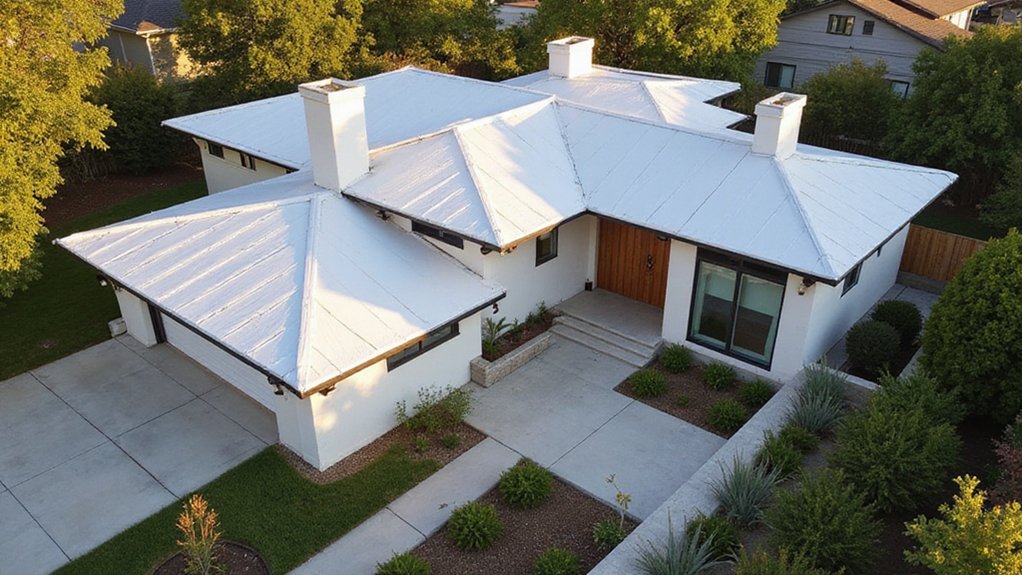The Best Ways to Insulate and Cool a Stucco Home

If you're struggling with keeping your stucco home cool and comfortable, you're not alone. Stucco homes present unique thermal challenges that can turn your living space into an uncomfortable heat trap. While traditional cooling methods often fall short, strategic insulation and cooling techniques can alter your home's energy efficiency. Want to learn how simple modifications can make a significant difference in your home's temperature control? The solutions might surprise you.
Understanding Stucco Home Thermal Characteristics
If you've ever wondered why your stucco home feels like an oven in summer or a refrigerator in winter, understanding its thermal characteristics is vital. Stucco's unique thermal mass properties help moderate indoor temperatures, storing heat during the day and releasing it slowly.
However, without proper air infiltration management, these benefits can be dramatically reduced. Your home's stucco walls act like a massive thermal sponge, absorbing and transferring heat, which means effective insulation becomes essential for maintaining comfortable indoor temperatures and managing energy efficiency. Stucco exterior insulation can significantly enhance your home's thermal performance and energy management capabilities.
Exterior Insulation Solutions
When addressing exterior insulation for stucco homes, homeowners have several effective strategies to improve thermal performance and energy efficiency.
External stucco finishing can include rigid foam boards or reflective barrier systems that reduce heat transfer and boost your home's comfort. These stucco exterior coatings create an additional layer of protection against temperature fluctuations, helping you maintain a consistent indoor environment. EIFS synthetic stucco provides superior energy efficiency through its multi-layered insulation system, delivering enhanced thermal protection for residential structures.
Interior Wall Insulation Techniques
The interior wall insulation of a stucco home provides homeowners a vital chance to improve thermal performance and energy efficiency.
You'll want to deliberate drywall insulation with rigid foam panels that can effectively diminish heat transfer and create a more comfortable living space. These insulation methods help seal air gaps, prevent temperature fluctuations, and lower your energy bills.
Advanced Window and Door Upgrades
After optimizing your stucco home's interior wall insulation, upgrading windows and doors represents the next strategic step in enhancing energy efficiency and comfort.
You'll want to evaluate installing glass block windows, which provide excellent insulation and natural light while maintaining privacy. Reflective window films can substantially reduce heat transfer, keeping your home cooler during hot summers.
High-performance, double-paned doors and windows with low-E coatings will further improve your home's thermal performance. These upgrades not only amplify your property's energy efficiency but also create a more comfortable living environment.
Roof and Attic Cooling Strategies
Since heat rises and can become trapped in your attic, implementing effective roof and attic cooling strategies becomes essential for maintaining a comfortable stucco home.
You'll want to focus on proper attic ventilation and choosing the right insulation types to manage heat buildup. Radiant barriers and reflective roof coatings can drastically reduce heat absorption, keeping your living spaces cooler.
Installing ridge vents, soffit vents, and attic fans helps circulate air and prevent heat accumulation. By strategically addressing your roof and attic, you'll create a more energy-efficient home that stays comfortable even during the hottest months.
Radiant Barrier Installation
Multiple studies suggest that radiant barriers can reduce cooling costs by up to 10-15%, making them a smart investment for stucco homeowners looking to improve energy efficiency. You'll want to install these reflective materials in your attic to block infrared heat transfer effectively.
Reflective paint application and infrared blocking film can help create a cooler home environment. By strategically placing these barriers, you'll reflect solar radiation away from your living spaces, keeping indoor temperatures more comfortable. The installation process isn't complicated, and the long-term benefits can substantially improve your home's energy performance and comfort level.
Smart Home Temperature Control Systems
Building on the energy-saving strategies we've examined with radiant barriers, smart home temperature control systems offer homeowners an advanced approach to managing indoor comfort and efficiency. You'll love how these wireless climate sensors connect seamlessly with your home's existing infrastructure, allowing precise temperature management from anywhere.
Smart climate automation lets you create custom cooling schedules, optimize energy usage, and reduce utility costs. By integrating intelligent technology, you can maintain consistent comfort while minimizing environmental impact. These systems not only improve your home's functionality but also provide peace of mind through intuitive, user-friendly controls.
Landscaping for Natural Temperature Regulation
When strategically planned, landscaping becomes a powerful tool for naturally regulating your home's temperature and reducing cooling costs. Native landscaping with carefully positioned shade trees can dramatically lower your home's exterior and interior temperatures.
Frequently Asked Questions
How Long Does Stucco Insulation Typically Last Before Needing Replacement?
You'll find stucco insulation typically lasts 20-30 years, depending on climate exposure, maintenance, and installation quality. Degradation factors like moisture, UV rays, and structural shifts can shorten its average lifespan.
Can I Improve Home Cooling Without Major Structural Modifications?
You can improve home cooling through simple window treatments like reflective blinds and strategic shade placement. Implement passive cooling strategies such as cross-ventilation and strategic landscaping to reduce indoor temperatures effectively.
What Are the Most Affordable Insulation Options for Stucco Homes?
You'll love spray foam insulation for its cost-effectiveness and rigid foam panels for their easy installation. These budget-friendly options will help you save money while keeping your stucco home comfortably cool and well-insulated.
Will Additional Insulation Significantly Reduce My Monthly Energy Bills?
You'll see significant energy bill reduction by focusing on insulation performance factors and aligning upgrades with your energy efficiency goals, potentially saving 20-30% on heating and cooling costs annually.
Are DIY Stucco Insulation Techniques Effective for Temperature Control?
You'll face DIY installation challenges with stucco insulation, but strategic techniques can improve temperature control while preserving your home's exterior appearance and helping you create a more comfortable living space.